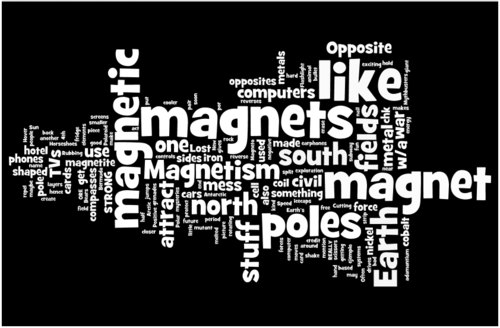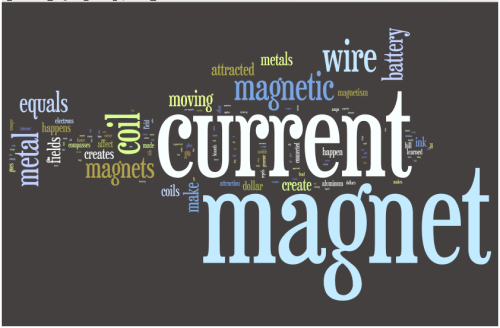I have run across many posts in the recent past explaining varied uses for Wordle in the classroom. (See this post from the Tech Savvy Educator, and this one from Clif’s Notes for some examples that come to mind.) While I appreciate the springboards that these many examples provide, I did notice that most posts collect many ideas together as opposed to describing the use within the context of a specific lesson design. Below, I describe the process my students used as an assessment for whole-class learning in my physics classes, where Wordle played an integral part. I hope that making my practice public can inspire each of you to improve on what I’ve tried- every time one of you shares how the lesson design works in your own classroom, we get a new opportunity to grow and learn from each other!
Pre-Assessment (The ‘Before’)
Before beginning our studies of magnetism, we had a quick class discussion around one question: “When you think of ‘magnetism,’ what comes to mind?” Using a little “write-pair-share” strategy, we made a list- as they shared aloud, I collected their responses in a Word doc projected on the board. After all three of my common preps completed this activity, we had three different classes’ “pre-assessed” knowledge around magnetism. Copying all of that text into a Wordle, we could now find the commonalities in our ideas:
This cloud gives the class a picture of what ‘we’ think in relation to magnetism. As the last conversation was a “class-ending” conversation the day before, the word cloud became a “class-starting” conversation the next day. We began class by examining this word cloud, questioning what it was that we would likely want to learn next about magnetism.
Learning Time (The ‘During’)
During this 2nd class period, several of the students who had experience in chemistry had a sneaking recollection that there was some relationship between electrons and magnetism, and became the leaders in a short class discussion around the concept of magnetic fields and magnetic domains. At that point in the lesson design, we had our “do some stuff with magnetic fields” time. Around the room were several demo stations related to the relationship between electricity and magnetism, where students had a central question to consider- “What Happens When I Do This?,” and “Why Do I Think It Happens?”
Following these experiences- which led students in all sorts of WHWYDT kinds of directions (both expected and unexpected)- we came together as a class to discuss what we had seen at these stations, and what questions had developed from the experiences. As a closing activity to the day, each student responded to a 1-question Google Form that asked the same question as their pre-assessment: “When you think of ‘magnetism,’ what comes to mind?”
The next class period, students entered class with this picture in front of them:
By taking the student responses and pasting them into a Wordle, we were able to see what “we” now think about magnetism. As a class, we compare this new word cloud to the first Wordle: by analyzing the similarities & differences between these two Wordles, the class is now examining what we have learned, and how our thinking has changed.
The unintended consequence- many students noted that our new responses went farther down the path of “induced” magnetism (that is, magnetism brought on by electric current), and farther away from the more typical concept of naturally magnetic materials. They wondered how we would connect these two ideas, as they still seemed disconnected in our thinking. This connection just happened to be the planned topic of study for the day, not only because it was part of our original pacing guide, but specifically because now we have noticed this trend in the “data” that the Wordle had presented. The students noticed that the dots were not connected, and the students wanted to connect them, which made the day’s learning much more authentic. It was not just something I was supposed to teach them: it had become something that they wanted to learn.
Generalizing for Lesson Design:
While not a flawless design, these six steps seemed paramount in increasing students’ desire to learn:
- Students pre-assessing their own knowledge and understanding – “What does _insert topic here_ mean to me?”
- Students using Wordle to analyze the pre-assessment responses
- Students “doing stuff” to experience _insert topic here_ in real life – “What happens when I do this?”
- Students responding to what they now know and understand – “What does _insert topic here_ mean to me today?”
- Students comparing the Wordle of their current thinking to that of their pre-assessment responses
- Students asking the question, “Given what I first thought, and what I now think, what do I think of next?“
Without the use of Wordle, we lose out on a central piece of this lesson design puzzle.
Have you used Wordle as a class assessment for learning with your students? Please share ideas, questions, and suggestions in the comments. If you decide to try out this lesson design with a topic in your class with your students, please consider sharing how it goes in the comments- learning from your experiences helps us all grow!


I absolutely love this lesson design, and love the fact that you’re using Wordle to show students how their understanding has changed over the course of the learning process. What a great visual way to demonstrate how their learning has grown!I have used Wordle as a self-evaluation tool to help students evaluate their own writing. First, students come up with the main idea of their paragraph. After they write a Then, they write their paragraph. After this, they put it into Wordle to see if they are making the point they want to make. For example, if they are writing about the light reactions of photosynthesis, their main idea would be that they convert light energy into usable chemical energy of ATP & NADPH. If, after writing their paragraph and putting it into wordle the largest word is "the," they haven’t really gotten their main idea across.
Thanks for the comment, Terie! It sounds like Wordle has been a major help for your students- I may need to employ that strategy with my own blog posts! 😉
I had a successful reading lesson with Wordle this week. My 4th grade class was reading Bud Not Buddy, and I asked them to write words on a sticky note that expressed the mood of the chapter. We then pasted our words into Wordle and made a word cloud based on kids’ responses. It turned out really cool.
Great article! We are linking to this particularly great article on our
website. Keep up the great writing.